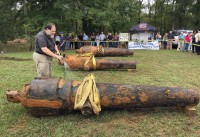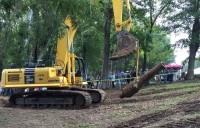 A team of archaeologists from the University of South Carolina have raised three Civil War cannons from the Pee Dee River in Mars Bluff, South Carolina. The cannons were the armament of the Confederate gunboat CSS Pee Dee which launched in January of 1865 and was deliberately scuttled by her crew just a month later when defeat seemed imminent. With the impending arrival of General William Tecumseh Sherman’s army fresh from putting Columbia to the torch, the crew jettisoned the ship’s guns into the river, dismantled the boat, set it on fire and set it adrift down the river.
A team of archaeologists from the University of South Carolina have raised three Civil War cannons from the Pee Dee River in Mars Bluff, South Carolina. The cannons were the armament of the Confederate gunboat CSS Pee Dee which launched in January of 1865 and was deliberately scuttled by her crew just a month later when defeat seemed imminent. With the impending arrival of General William Tecumseh Sherman’s army fresh from putting Columbia to the torch, the crew jettisoned the ship’s guns into the river, dismantled the boat, set it on fire and set it adrift down the river.
 The three cannons are two Brooke rifles, a 6.4-inch and a 7-inch, and a 9-inch Dahlgren smoothbore which was originally a Union weapon. The cannon was salvaged from the wreck of the USS Southfield after it was sunk by the formidable Confederate ironclad ram CSS Albemarle during the Battle of Plymouth on the Roanoke River in Plymouth, North Carolina, on April 19th, 1864. The Albermarle had been commissioned literally two days earlier and would cut a deadly swath through the Union Navy until she was brought down in October of 1864 by Lieutenant William B. Cushing in a raid so daring it belongs in a Dumas novel.
The three cannons are two Brooke rifles, a 6.4-inch and a 7-inch, and a 9-inch Dahlgren smoothbore which was originally a Union weapon. The cannon was salvaged from the wreck of the USS Southfield after it was sunk by the formidable Confederate ironclad ram CSS Albemarle during the Battle of Plymouth on the Roanoke River in Plymouth, North Carolina, on April 19th, 1864. The Albermarle had been commissioned literally two days earlier and would cut a deadly swath through the Union Navy until she was brought down in October of 1864 by Lieutenant William B. Cushing in a raid so daring it belongs in a Dumas novel.
The Southfield‘s Dahlgren was transported by train to the Mars Bluff Naval Yard where it was mounted on the Pee Dee. It wasn’t mounted on a traditional carriage, however, which one of the reasons the cannons are of particular historical significance. All three of the Pee Dee‘s guns were swivel mounted so they could turn a full 360 degrees. The Pee Dee was the only ship ever built at the Mars Bluff Naval Yard. The Confederacy had no navy when the war began. The naval yard was one of a few constructed inland, safe from Union interference, with the aim of producing vessels that could harry the Union blockade choking Confederate shipping.
 Two of the guns, the 6.4-inch Brooke and the Dahlgren, were discovered in 1995 and 2006 by amateur diver Bob Butler of the Pee Dee Research and Recovery Team. The wreck itself was found in 2010 by the University of South Carolina’s Maritime Research Division. It turns out to have caught on the first bend of the river, but because of its destruction and drifting, the debris field is spread over a great deal of the river and several parts of the ship — the propellers, the boilers — have been salvaged by locals over the decades.
Two of the guns, the 6.4-inch Brooke and the Dahlgren, were discovered in 1995 and 2006 by amateur diver Bob Butler of the Pee Dee Research and Recovery Team. The wreck itself was found in 2010 by the University of South Carolina’s Maritime Research Division. It turns out to have caught on the first bend of the river, but because of its destruction and drifting, the debris field is spread over a great deal of the river and several parts of the ship — the propellers, the boilers — have been salvaged by locals over the decades.
The third cannon was finally located in 2012. Unlike the other guns which were found in alignment close to the riverbank, the 7-inch Brooke was deeper in the water. It was discovered thanks to adjacent landowners Dutton and Rufus Perdue who took advantage of extreme low water levels which had exposed two piling stumps to search the river with metal detectors. They found a large anomaly and alerted the University team. Although they initially hoped to raise the cannons in late 2013, it took another two years for everything to get sorted out, so this has been a long time in coming.
 The weapons appear to be in very good condition. They’ve been softly treated by the fresh water of the Pee Dee and retain identification markers like serial numbers and foundry marks. The cannons have a new home: the Warren Lasch Conservation Center in North Charleston where the CSS Hunley submarine is being conserved. After an estimate two-year process of stabilization and conservation, the cannons will be put on display in the Florence County Museum.
The weapons appear to be in very good condition. They’ve been softly treated by the fresh water of the Pee Dee and retain identification markers like serial numbers and foundry marks. The cannons have a new home: the Warren Lasch Conservation Center in North Charleston where the CSS Hunley submarine is being conserved. After an estimate two-year process of stabilization and conservation, the cannons will be put on display in the Florence County Museum.